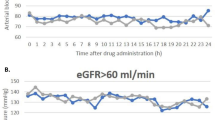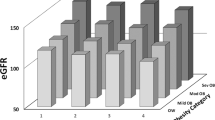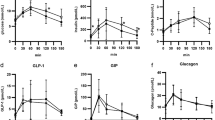Abstract
OBJECTIVES: Insulin-resistance syndrome and hyperinsulinaemia are linked with cardiovascular disease (CVD) in the obese population. In particular, cardiovascular risk is more frequent in central obesity and is associated with microalbuminuria (MA). MA and changes of glomerular permeability to proteins in obesity might be related with renal haemodynamic modifications (that is glomerular hyperfiltration). Since glucagon is physiologically involved in renal haemodynamic regulation, the purpose of this study was to examine whether changes of circulating glucagon levels might haemodynamically induce MA and proteinuria in patients with central obesity.
SUBJECTS: Forty normotensive obese out-patients, 22 with central (CO group) and 18 with peripheral (PO group) body fat distribution and 11 healthy subjects.
MEASUREMENTS:Serum insulin and glucagon concentrations (fasting and after oral glucose tolerance test (OGTT)) by radio immuno assay (RIA); glomerular filtration rate (GFR, isotopic); total clearances and urinary excretion rates of albumin (AER), IgG (IgGER) and α1 microglobulin (computerized immunonephelometry).
RESULTS: GFR and insulin concentrations (fasting and during OGTT) were higher in the CO than the PO group. Fasting glucagon concentrations were increased, and not physiologically suppressed during OGTT in patients with CO (fasting, P<0.05; OGTT 60 and 120 min, P<0.001 vs PO group). Moreover, glucagon concentrations were significantly correlated with GFR in the CO group (fasting, r=0.49, P<0.05; 60 min after OGTT, r=0.58, P<0.01); whereas no correlations were found in the PO group. Higher AER (P<0.001), IgGER (P<0.001) and α1 microglobulin (P<0.05) urinary concentrations were found in patients with CO than in the PO group.
CONCLUSIONS: The increase of serum glucagon concentrations may be associated with the enhancement of GFR in patients with central obesity. Glomerular hyperfiltration might influence the development of MA and of proteinuria by means of a haemodynamic mechanism so contributing to increase the risk of renal microvascular complications and of CVD in central obesity.
This is a preview of subscription content, access via your institution
Access options
Subscribe to this journal
Receive 12 print issues and online access
$259.00 per year
only $21.58 per issue
Buy this article
- Purchase on Springer Link
- Instant access to full article PDF
Prices may be subject to local taxes which are calculated during checkout
Similar content being viewed by others
Author information
Authors and Affiliations
Corresponding author
Rights and permissions
About this article
Cite this article
Solerte, S., Rondanelli, M., Giacchero, R. et al. Serum glucagon concentration and hyperinsulinaemia influence renal haemodynamics and urinary protein loss in normotensive patients with central obesity. Int J Obes 23, 997–1003 (1999). https://doi.org/10.1038/sj.ijo.0801032
Received:
Revised:
Accepted:
Published:
Issue Date:
DOI: https://doi.org/10.1038/sj.ijo.0801032
Keywords
This article is cited by
-
How common is Balkan endemic nephropathy among immigrants in endemic regions?
International Urology and Nephrology (2018)
-
Improvement of Kidney Function Following Bariatric Surgery: Hope or Illusion?
Obesity Surgery (2015)
-
Impact of obesity severity and duration on pancreatic β- and α-cell dynamics in normoglycemic non-human primates
International Journal of Obesity (2013)
-
The potential role of glutamate in the current diabetes epidemic
Acta Diabetologica (2012)
-
Effects of thiazolidinediones on cardiovascular risk factors
Comprehensive Therapy (2002)



